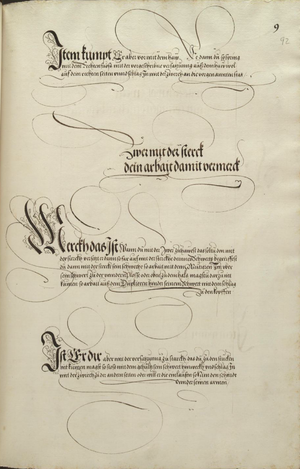|
|
You are not currently logged in. Are you accessing the unsecure (http) portal? Click here to switch to the secure portal. |
User:Kendra Brown/Latin Lew/86r
Munich 86r / PDF page 17
Contents
Missing zettel verses from PHM Dresden 92r (21)
German
- Zwer mit der sterck
- dein arbait damit vermerck
English (Fritz)
- Twer with the strong/strength.
- Mark your work with this.
Notes
This means the strength of the body as well as the strong of the sword.
86r a
86r a Latin
- Tum etiam maxime curabis transversarium feriundo, ut totis viribus id fiat,
- vel loco ensis firmiori, adversario aute[m] id excipiente, tu si firmiorem ensis partem
- sustuleris, atq[ue] ea parte ipsius hostis infirmiorem senseris, Mutationibus sup[er] eius
- ense directis versus infernas nuditates utitor, vel si mavis versus collu[m] ipsius. Veru[m]
- si id nequibis, co[n]duplationes retro ipsius gladiu[m] exerceas, inde autem curabis ut
- adversarij caput concutias.
86r a English
Then also especially undertake striking the transverse, to do it with all strength, or at the stouter part of the sword, IT also having been intercepted by the adversary, if you lift the stouter part of the sword, and if using this part you perceive the weaker of the enemy himself, use alterations ~shiftings~ directed above his sword toward the lower openings, or if you prefer toward his neck. Truly, if you cannot do this, employ repetitions to the back of his sword, thence also undertake that you should crash into the head of the adversary.
86r a notes
parallel phrase (Two targets), present in german
86r b
86r b Latin
- Caeterum si hostis adeò acriter se defendat, ut co[m]memoratos habitus
- exercere no[n] possis, capulo ensis tui, adversarij gladiu[m] repellas, atq[ue] transversario alter[um]
- eius latus quasses, at si incurrere conetur, sub brachijs ipsius incisionis habitu[m] exer-
- ceas.
86r b English
- The other/the remaining things
- if the enemy defends himself so fiercely, that you are not able to employ the remembered/related gestures, using the hilt of your sword, you drive back the sword of the adversary and batter his other side with the transverse, or if on the other hand he tries to run in, practice the gesture of incising under his arm.
86r b notes
Missing zettel verses from PHM Dresden 92v (22)
German
- Zweer zu dem pflug
- zu dem Ochsenhart gefug
- was sich vol zweret
- mit springen dem haubt geferet
English (Fritz)
- Zwer to the Pflug,
- harm the Ochs hard.
- A good Zwer
- is a danger to the head with a leap.
86r c
86r c Latin
Alius transversarii usus,
- In p[re]cede[n?]tibus dictu[m] est, q[uam?] Bos, et aratr[um] duo castra, vel custodi[a]e sint, hoc aute[m] loco qua-
- tuor nuditates appella[n?]t[ur] Bos et aratru[m]. Bos, du[a]e sup[er]iores nuditates, hoc est, dextru[m] & sinis-
- trum latus capitis. Aratr[um], du[a]e nuditates inferiores, id est duo latera infra cingulum.
- Eas igitur nuditates Transfersario pervestigabis in accedendo ad hostem.
86r c English
In the preceding it has been said, how the Ox and the plow \[may be\] two military camps, or they may be guards, here, on the other hand, four openings are called Ox and plow. The Ox, two openings above, this is, the right and left sides of the head. The Plow, two openings below, that is two sides below the belt. These openings therefore explore thoroughly using the Transverse in the approach of the enemy.
86r c notes
two phrases explaining one concept here, present in german
86r d
86r d Latin
- Quum ad adversarium accesseris, et is contra te in custodia de die constiterit,
- tu[m] adversus eu[m] in latus dextr[um] prosilias dextro pede, atq[ue] totis viribus transfersarium
- lateri capitis eius sinistro, quod Bos dicitur, infligas superné, at si eum impetu[m]
- repellat hostis, mox latus inferius dextru[m], quod prope vel sub cingulu[m] constat, in-
- ferné, quod aratru[m] dicitur. atq[ue] ita porrò Transversarios alternatim exerceas, facto
- altero superné, mox inferné aratru[m] concutias crucis instar.
86r d English
When you would come near to the adversary, and he stands against you in the guard of the day, then advance the right foot against him toward the right side, and with all strength, dash the transverse above against the left side of the head, which is called Ox, and if the opponent repels that forward attack, next [attack with the transverse] below at the lower right side, which stands near or below the belt, which is called plow. And so hereafter employ the Transverse alternately, first above, next below brandish the plow in the likeness of the cross.
86r d notes
dictionary lookups:
parallel phrase referring to target area; German does not mention belts or areas near them in this paragraph but it's in the previous one.

